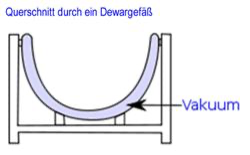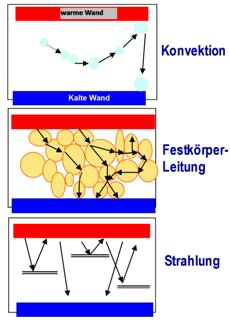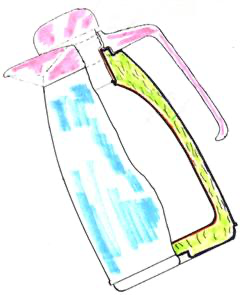Supported Vacuum-Insulation (“GVI-Systems”)

Source: Dewar flask at Wikipedia


What are the advantages of vacuum insulation?
The very good insulating properties of a vacuum are known to everyone (perhaps only unconsciously) from everyday use: thermos keep drinks and food warm or cold for a long time.
The actual insulating vessel is designed as a double-walled, vacuum-tight hollow body; the annular space between the two shell walls is evacuated. As a result, one of the main heat conduction mechanisms – heat conduction via gases (also called convection) – is switched off. Such insulating vessels were first developed and built in 1874 by the English physicist James Dewar – which is why they are still called Dewar vessels today.
Another essential heat conduction mechanism is solid-state heat conduction, which depends very much on the respective material (metallic materials are – in contrast to e.g. glass or ceramic materials – usually very good heat conductors). Since there are no solids in the evacuated annular space of a Dewar vessel, this heat conduction mechanism does not come into play here either.
The third heat conduction mechanism is thermal radiation. Thermal radiation is not bound to matter and therefore also spreads in a vacuum (example of heat transfer from the sun to the earth through the largely vacuum of space). In order to prevent the proportion of radiation in a Dewar vessel, the walls of the isolation room are mirrored (first presented by Dewar in 1893) – the radiation is therefore reflected.
Dewar vessels must be evacuated down to the high vacuum range (p< 10-4 mbar) and cannot withstand pressure. The production of large containers is therefore associated with a great deal of effort and is often impossible if there are deviations from the rotational symmetry. (The same also applies to the so-called multilayer systems, which are often used in cryo and space technology.)
What is Supported Vacuum Insulation – GVI®?
(GVI® is a registered trademark of König Metall and TEB)
GVI® systems also consist of a double-walled, vacuum-tight shell structure that is evacuated. However, here the insulation space is completely filled with a microporous (often also nanoporous) filling material. Basic considerations on the use of such materials were already made in 1910 by Smoluchowski. He examined convection in finely porous powders and proved that gas molecules in the vicinity of vessel walls (here the pore walls) lose their normal mobility, which is noticeable as a temperature discontinuity. The mean free path of the gas molecules enclosed in a pore is already very large at high residual gas pressures!
(This also corresponds to the experience from vacuum technology that large Knudsen numbers must be expected in capillaries and fine-pored beds – the molecular flow may already set in in the rough vacuum range!).
The vacuum effect (here the most extensive suppression of convection), which is only achieved in a Dewar vessel at a residual gas pressure of p < 10-4 mbar, accordingly occurs in correspondingly fine, micro- or even nanoporous powder beds at residual gas pressures of around 0.1 < p < 10 mbar a.
In addition, the filler in such vacuum insulation has a more or less pronounced support function – such insulation can withstand pressure and it is possible to produce large-area, flat wall elements or to transfer forces/torques – without additional support elements – into the insulation layer and towards the outer skin transfer!
